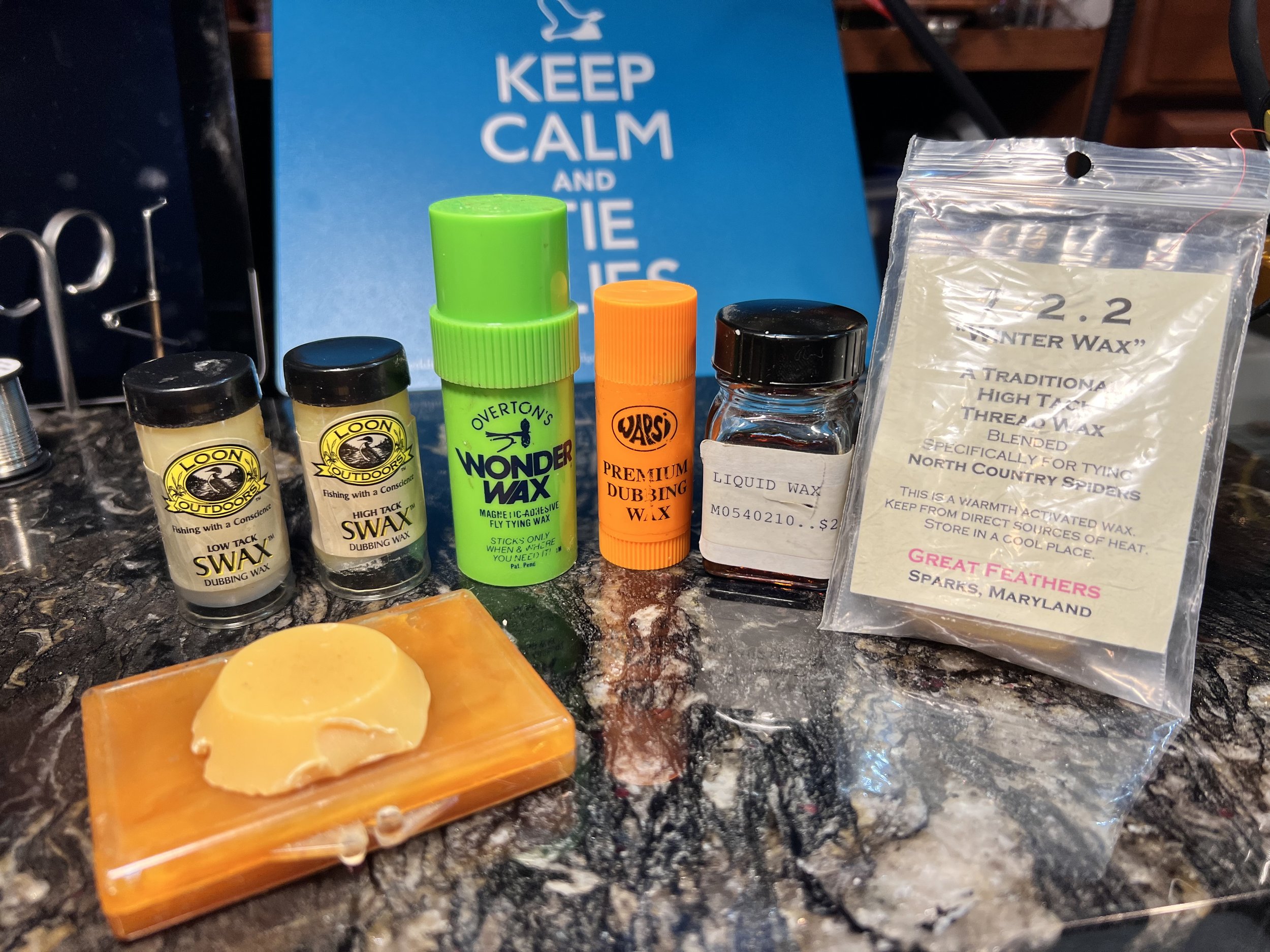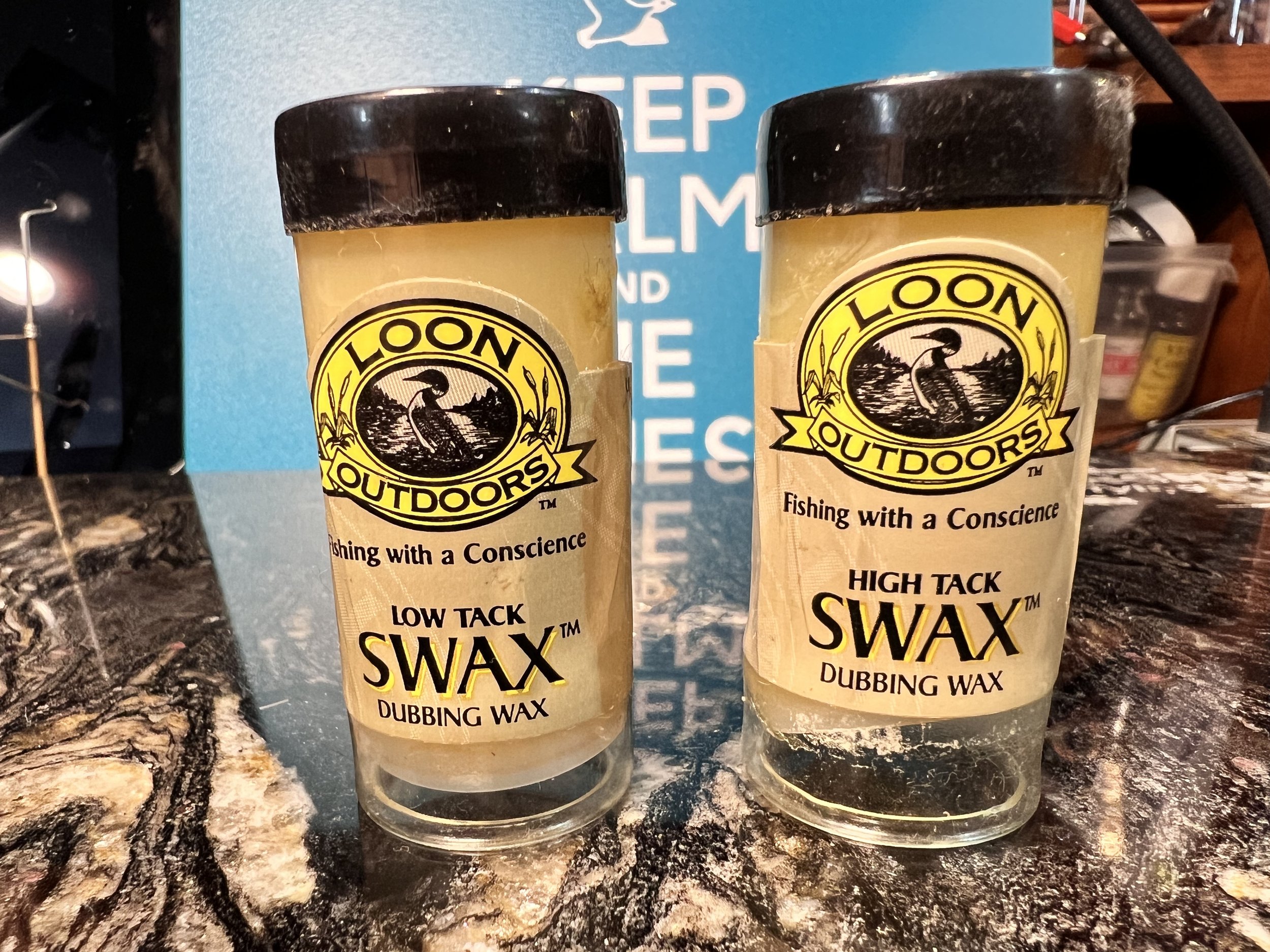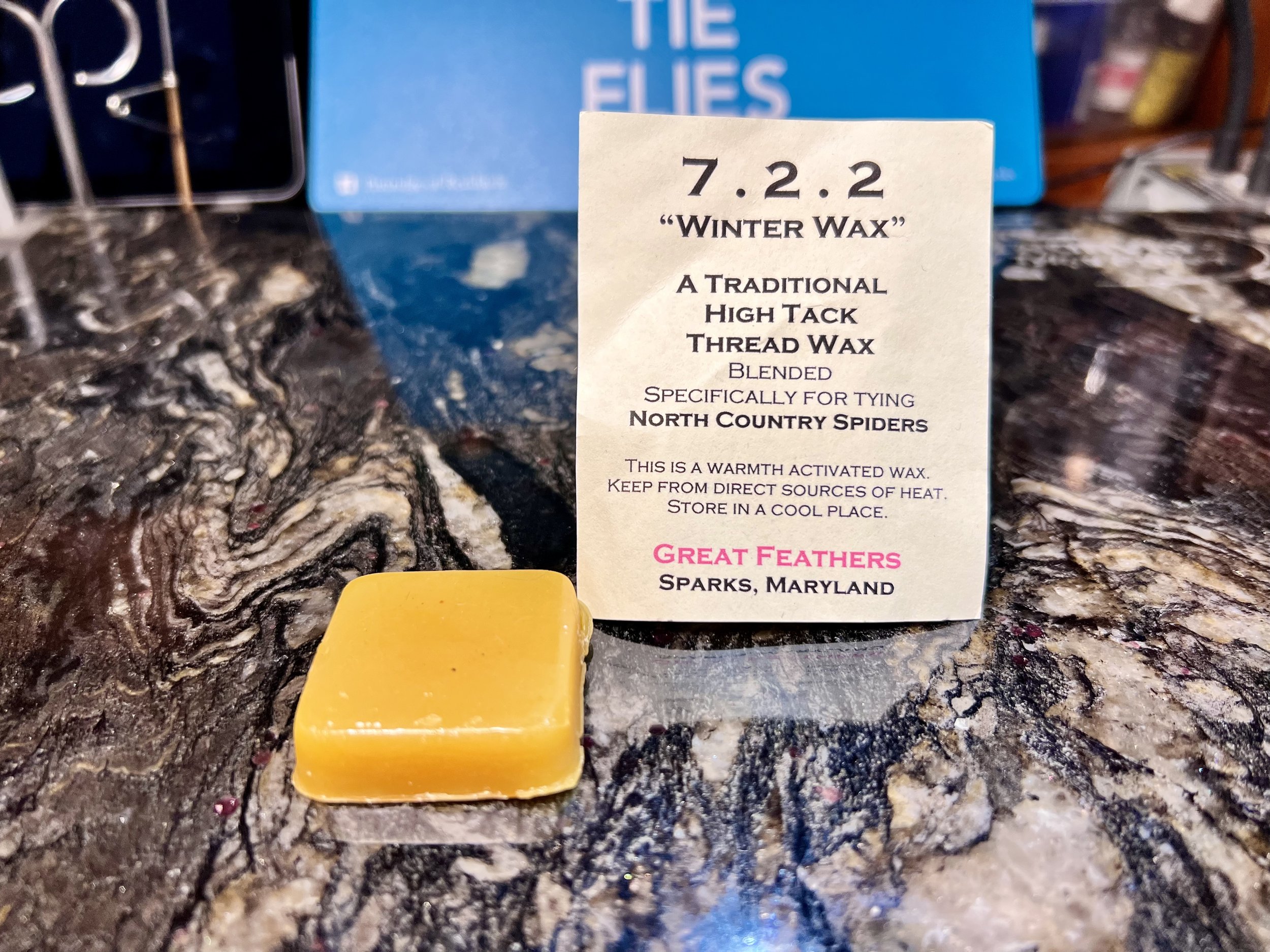One of the most common questions I am asked when tying flies at shows and exhibitions is, "What is that lump on your finger you keep rubbing on the thread?" That "lump" is a small amount of wax that I have warmed in my fingers and shaped into a small ball which I then stick onto the index finger of my right hand. I have found this little deposit of wax on my finger is quicker and easier than reaching for a piece of wax every time I want to apply wax to my thread.
A small piece of thread wax stuck to the index finger of my hand makes it quick and easy to apply wax to the thread when needed.
I lump wax into two categories fly tying wax and dubbing wax. Let's talk about the differences between them. Thread wax is a hard wax usually sold in a small lump or puck. It has a hard, smooth surface. When the thread is drawn up against this wax, it leaves the thread tacky allowing the thread to grip slippery materials and bind them to the hook shank without slipping. Some thread brands like UTC and Danville are smooth and somewhat slick and benefit more from waxing. Threads like Semperfli Classic Waxed, Veevus, and UNI-Thread have more texture and typically require less wax. Semperfli's Classic Waxed Thread is my go-to thread these days. You get more thread per spool, and it is stronger, lays flat, splits easily, and is available in a great range of colors.
Although I have never conducted any scientific test to prove it, I feel wax strengthens the thread and protects it from fraying, and it will make your finishing half hitches and whip finishing knots stronger and less likely to come undone. I work with many animal hairs like bucktail, squirrel tail, and calf tail which are notoriously slippery materials. A proper application of wax before tying in the materials makes all the difference in the world. If you have ever struggled to keep slippery materials in place on your hook, thread wax may solve all of your problems.
The chunk of thread wax I have been using for years, As you can see I have used very little of it.
Prepping your wax for use
Thread Wax or Fly Tying Wax is usually sold in a solid chunk instead of the tube in which most dubbing waxes come. So the wax must be softened and worked a bit to bring out all its tackiness. However, some tiers prefer to use the wax in its original form by dragging a length of thread across its surface. Unfortunately, I have found that this method can sometimes fray or even break fine threads.
I prefer to break small chunks of wax off the puck and soften it by working it between my fingers until it becomes pliable and sticky. I will then stick a small amount of this prepared wax to my index finger, ready to apply to the thread whenever I need it. Davie McPhail has an excellent tutorial on his YouTube channel on preparing this wax for use when fly tying. His hot water trick works very well, but in a pinch, when no hot water is available, I break a small piece of the chunk and roll it around in my fingers until my body heat and the heat caused by friction soften the wax enough for use and allow it to stick to my finger.
Using thread wax
Applying tying wax to your thread strengthens it and makes it slightly sticky or tacky. Wax helps hold slippery materials in place on the hook and will strengthen the knots you use to keep it all together. With the wax prepared and stuck to the side of my index finger, I drag a length of thread across the disk of wax and tie as usual. I apply a tiny bit of wax to my thread whenever I am binding material to the hook or tying a knot. It's that simple. It is also beneficial when working with silk threads as it makes them easier to work with by stiffening them, reducing fraying, and making them mildew and water-resistant. I will also use it when working with dubbing, but other forms of wax are better suited to that.
After the fly tying session I remove the wax from my finger and stick it to what ever vise I was using. You will find a small chunk of wax stuck to every vise I own!
Dubbing Wax
Dubbing wax is a much softer wax meant to be applied to the thread or your fingers to assist in the application of dubbing. Dubbing wax typically comes in low-tack and high-tack consistencies.
Using Dubbing Wax
Most fly tiers use too much dubbing wax, which causes it to build up on the thread in unsightly, sticky clumps. When applying wax to your thread you should use just a hint of it. If you feel more wax is needed to work with a coarse material like seal's fur or some thicker synthetics, try reaching for a tube of high-tack or sticky wax and use it sparingly. Better yet, try applying a thin film to your fingertips. Doing this will help you get the dubbing worked onto the thread and help you build a dubbing noodle without clumps. You use so little dubbing wax that a full container may last you a lifetime, with some to leave to your children and grandkids!
Think of dubbing wax as something that provides traction instead of adhesion like glue or cement. Its purpose is to help you work with the materials, not glue them to the thread or hook. Similar to licking your fingers to shuffle through a stack of papers. Something you would not want to do with natural or dyed materials. Furs, hides, and synthetics all contain chemicals or biological agents you do not wish to ingest regularly.
Using Wax From Tubes:
Dubbing wax is often sold in a lipstick-like tube. Unfortunately, most fly tiers expose too much wax at the top of the tube when applying it to their thread. The wax should barely stick above the top of the tube, no more than a thread width or two. If more wax shows, the thread will cut grooves into the wax and deposit excessive wax on the thread. Appropriately done, the thread should end up tacky without visible wax deposits. Clumps of wax on the thread will produce messy-looking flies with lumpy uneven bodies.
This is an example of how much wax should extend over the top of the tube.
If your tube of wax looks like the top image you have too much wax exposed. Running a length of thread through it will leave large clumps of wax stuck to the thread and your dubbed bodies will not come out right.
Other Types of Waxes:
Liquid Wax: This is a specialized wax that is not very common. The only time I use it is when making dubbing brushes. I applied a light coat of wax with a brush to the thread when it is mounted in my dubbing twister before applying the dubbing.
My aging bottle of liquid wax used for making dubbing brushes.
Homemade Waxes: If you search the internet, you will find dozens of recipes for making your own dubbing wax. I will share my recipe in another post. I use my homemade wax to apply directly to my fingers. Storing the wax in a thin flat container makes it easy to swipe your fingers across the surface to apply a light film of wax.
My homemade wax container opened and ready for use.
Winter Wax: Winter wax is a wax that is temperature sensitive and softens quickly when a little heat is applied by breaking off a small chunk and working it with your fingers.
Winter wax is another favorite wax of mine. I was forced to buy a new package after leaving one behind at a fly tying demo. this little brick should last you many years.
Semperfli Waxes:
Cobbler Wax: Semperfli produces three different types of wax for the fly tier. Their Cobblers Wax is designed to be used with their Primrose Standard and Silk Threads to get the perfect Greenwells color. If you tie Greenwells it is indispensable.
Semperfli Cobblers Wax
GSP Wax: This wax has been specially formulated to use with Nano Silk and other GSP threads on the market. Some waxed are too harsh for the fine but extremely strong fibers of GSP threads. Semperfli GSP Wax will glide across your GSP threads and color them black and create a tacky, waxed surface for you to add dubbing, to tie on or tie off your GSP threads
Fly Tyers Wax: This is a standard fly tyers wax. Add a little wax directly onto your thread, and then use your chosen technique for dubbing. Semperfli Prepared Fly Tyers Wax works with all dubbing styles - directly onto the thread, splitting the thread, or making a dubbing loop.
In a future post, we will address working with dubbing and will revisit putting wax to use in constructing your flies. Stay tuned…
Do you have a favorite wax or a unique way of using it? If so, leave a comment on this post.
Notes From The Fly Tying Bench will be a regular monthly feature in the future. Look for a new monthly post sharing fly-tying tips, tricks, and know-how.












